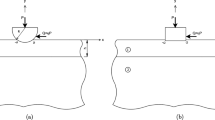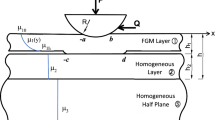Abstract
This paper investigates the contact problem of an elastic layer that is perfectly attached to a porous half-space by two rigid flat punches with collinear symmetry. Using integral transformation, the problem is condensed to a singular integral equation of the Cauchy type. Then, the exact expressions for the surface contact stress and surface interface displacement are provided. By using the Gauss–Chebyshev technique, the integral equations are solved numerically, and the variations of the unknown contact stresses and deformations for different parameters are addressed. The results indicate that stress concentration is typically higher on the outer edge of the contact area compared to the inner edge. This also explains why surface damage is more likely to occur on the outer edge in elastic and poroelastic materials. Due to the interaction between the two punches, there will be a superposition of normal displacements at the center. The deformation or bulging at the center can be managed by adjusting the parameter values, allowing the engineered material to fulfill its intended purpose. The potential applications of these research findings encompass safeguarding porous structures against contact-related deformation and damage.
































Similar content being viewed by others
References
Biot MA (1941) General theory of three-dimensional consolidation. J Appl Phys 12(2):155–164. https://doi.org/10.1063/1.1712886
Biot MA (1955) Theory of elasticity and consolidation for a porous anisotropic solid. J Appl Phys 26(2):182–185. https://doi.org/10.1063/1.1721956
Chebakov MI, Kolosova EM (2021) Contact interaction of an axisymmetric stamp and an elastic layer fixed on a poroelastic base. Mech Compos Mater 56(6):769–778. https://doi.org/10.1007/s11029-021-09922-9
Chebakov MI, Poddubnyy AA, Kolosova EM, Alexiev AR, Datcheva M (2020a) Contact interaction of axisymmetric indenter and poroelastic foundation. Mater Phys Mech 44:423–432. https://doi.org/10.18720/MPM.4432020_13
Chebakov MI, Poddubnyy AA, Kolosova EM, Alexiev AR, Iankov RZ (2020b) Contact interaction of axisymmetric indenter and poroelastic layer. C R Acad Bulg Sci 73(6):846–855. https://doi.org/10.7546/CRABS.2020.06.13
Chebakov MI, Kolosova EM, Iankov RZ, Datcheva M (2021) Contact problem for a rigid flat stamp and a linear elastic strip bonded to porous half-plane. J Theoret Appl Mech 51(3):391–404
Cowin SC, Nunziato JW (1983) Linear elastic materials with voids. J Elast 13:125–147. https://doi.org/10.1007/BF00041230
Cowin SC, Puri P (1983) The classical pressure vessel problems for linear elastic materials with voids. J Elast 13(2):157–163. https://doi.org/10.1007/BF00041232
Dong XQ, Zhou YT, Wang LM, Ding SH, Park JB (2014) Stress state of two collinear stamps over the surface of orthotropic materials. Arch Appl Mech 84(5):639–656. https://doi.org/10.1007/s00419-014-0822-5
Gao Y (2018) Strength and fracture of anisotropic poroelastic media. Tsinghua University, Beijing
Huang RK, Ding SH, Chen Q, Lv CF, Zhang X, Li X (2022) Sliding frictional contact of one dimensional hexagonal piezoelectric quasicrystals coating on piezoelectric substrate with imperfect interface. Int J Solids Struct 239–240:111423. https://doi.org/10.1016/j.ijsolstr.2022.111423
Ieşan D, Nappa L (2003) Axially symmetric problems for a porous elastic solid. Int J Solids Struct 40(20):5271–5286. https://doi.org/10.1016/s0020-7683(03)00229-4
Kolosova EM, Chebakov MI (2020) Analytical solution of axisymmetric contact problem for a poroelastic layer. Mech Solids 55(6):857–864. https://doi.org/10.3103/S0025654420050118
Lai D, Chen X, Xu X, Wang G, Wang Y (2022) Elastomeric foldable and high-temperature endurance porous graphene films with superior electromagnetic interference shielding performance. Ind Eng Chem Res 61(2):1122–1132. https://doi.org/10.1021/acs.iecr.1c04201
Liu M, Huang HY (2021) Poroelastic response of spherical indentation into a half space with an impermeable surface via step displacement. J Mech Phys Solids 155:104546. https://doi.org/10.1016/j.jmps.2021.104546
Nunziato JW, Cowin SC (1979) A nonlinear theory of elastic materials with voids. Arch Rational Mech Anal 72:175–201. https://doi.org/10.1007/BF00249363
Puri P, Cowin SC (1985) Plane waves in linear elastic materials with voids. J Elast 15:167–183. https://doi.org/10.1007/BF00041232
Samea P, Selvadurai AP (2020) A contact problem for a poroelastic halfspace containing an embedded inextensible membrane. Int J Numer Anal Methods Geomech 44(16):2167–2188. https://doi.org/10.1002/nag.3130
Scalia A (2002) Contact problem for porous elastic strip. Int J Eng Sci 40(4):401–410. https://doi.org/10.1016/s0020-7225(01)00070-2
Scalia A, Sumbatyan MA (2000) Contact problem for porous elastic half-plane. J Elast 60(2):91–102. https://doi.org/10.1023/A:1010880823544
Scalia A, Sumbatyan MA (2003) On the properties of integral equations arising in contact problems for porous elastic strip. Eur J Mech A 22(3):489–496. https://doi.org/10.1016/s0997-7538(03)00027-5
Selvadurai AP, Samea P (2020) On the indentation of a poroelastic halfspace. Int J Eng Sci 149:103246. https://doi.org/10.1016/j.ijengsci.2020.103246
Selvadurai AP, Samea P (2021) Mechanics of a pressurized penny-shaped crack in a poroelastic halfspace. Int J Eng Sci 163:103472. https://doi.org/10.1016/j.ijengsci.2021.103472
Slater AG, Cooper AI (2015) Function-led design of new porous materials. Science 348(6238):aaa8075. https://doi.org/10.1126/science.aaa8075
Xiao J, Xiong Y, Chen J, Zhao S, Chen S, Xu B, Sheng B (2022) Ultrasensitive and highly stretchable fibers with dual conductivemicrostructural sheaths for human motion and micro vibration sensing. Nanoscale 14(5):1962–1970. https://doi.org/10.1039/D1NR08380E
Xiao HP, Zhang F, Yin SX, Cheung CF, Wang CJ (2023) Subsurface damage model in single and double scratching of fused silica with a blunt indenter. Int J Mech Sci 250:108309. https://doi.org/10.1016/j.ijmecsci.2023.108309
Xu ZL (2016) Elasticity. Higher Education Press, Beijing
Yang YL, Ding SH, Wang WS, Wang X, Li X (2022) The numerical algorithms of infinite integrals involving products of Bessel functions of arbitrary order. Comput Appl Math 41(3):116. https://doi.org/10.1007/s40314-022-01816-3
Zhang YL, Ma HL, Yang J, Ding SH (2022) Frictionless multi-field coupling contact problem for a thermoelectric layer loaded by two rigid punches. Acta Mech Solida Sin. https://doi.org/10.1007/s10338-022-00355-y
Zhang P, Wang W, Zheng Y, Hu S (2023) Effect of recycled aggregate and slag as substitutes for natural aggregate and cement on the properties of concrete: a review. J Renew Mater 11(4):1853–1879. https://doi.org/10.32604/jrm.2023.024981
Zhou YT, Kim TW (2014a) Closed-form solutions for the contact problem of anisotropic materials indented by two collinear punches. Int J Mech Sci 89:332–343. https://doi.org/10.1016/j.ijmecsci.2014.09.017
Zhou YT, Kim TW (2014b) Two electrically-conducting stamps on the surface of piezoelectric materials. Int J Eng Sci 81:146–162. https://doi.org/10.1016/j.ijengsci.2014.04.013
Zhou YT, Zhong Z (2015) The interaction of two rigid semi-cylinders over anisotropic piezoelectric materials by the generalized Almansi theorem. Smart Mater Struct 24(8):085011. https://doi.org/10.1088/0964-1726/24/8/085011
Zhou YT, Pang SJ, Jang YH (2017) Magneto-electro interaction of two offset indenters in frictionless contact with magnetoelectroelastic materials. Appl Math Model 52:197–214. https://doi.org/10.1016/j.apm.2017.07.041
Acknowledgements
This study was financially supported by the Ningxia Natural Science Foundation (Nos. 2022AAC03012 and 2022AAC03001), the National Natural Science Foundation of China (Nos. 12272195 and 12262033) and Ningxia Science and Technology Leading Talent Training Program (No. 2022GKLRLX04).
Author information
Authors and Affiliations
Contributions
YY and WW designed the research and drafted the manuscript. SD and XL provided constructive ideas and suggestions for the manuscript. All authors have strengthened the quality of the article.
Corresponding authors
Ethics declarations
Competing interests
The authors declare no competing interests.
Additional information
Publisher's Note
Springer Nature remains neutral with regard to jurisdictional claims in published maps and institutional affiliations.
Appendices
Appendix 1: Several lemmas and the proofs concerned
Lemma 1
The abnormal integral \(\int_{0}^{\infty } {\sin (sx)} {\text{d}}s\;(x \ne 0)\) converges to \(\frac{1}{x}(x \ne 0)\).
Proof
Let \(\xi = sx\), then
By the accumulation of integral intervals \([0,\infty ) = [0,c] \cup [c,\infty ),( - \infty ,0] = ( - \infty , - c] \cup [ - c,0]\) and the Dirichlet discriminance, we know that \(\int_{0}^{\infty } {\sin (sx)} {\text{d}}s\;(x \ne 0)\) is convergence. From the continuity of infinite integrals with parametric variables, we can obtain
then,
So, we have
□
Lemma 2
Cauchy convergence criterion: infinite integral \(\int_{{m_{1} }}^{\infty } {f(x)} {\text{d}}x\) is convergence \(\Leftrightarrow\)\(\forall \varepsilon > 0\), \(\exists N > m_{1} \& N > 0\), \(\forall p_{1} ,p_{2} > 0\), then \(\left| {\int_{{p_{1} }}^{{p_{2} }} {f(x)} {\text{d}}x} \right| < \varepsilon\).
Lemma 3
Infinite integral \(\int_{{m_{1} }}^{\infty } {f(x)} {\text{d}}x\) is convergence \(\Leftrightarrow\)\(\forall m_{1} \ne m_{2}\), infinite integral \(\int_{{m_{2} }}^{\infty } {f(x)} {\text{d}}x\) is convergence.
Appendix 2: Parameter values needed for plotting
Figure | Parameter value | Figure | Parameter value |
|---|---|---|---|
Figure 4a | \( \begin{aligned} & d = 1,N = 0.5,\nu _{e} = \nu _{p} = 0.3, \hfill \\ & \mu = 0.5,\tilde{P} = 0.5,\tilde{a} = 0,\tilde{b} = 1 \hfill \\ \end{aligned} \) | Figure 4b | \(\begin{aligned} & d = 0.25,N = 0.5,\nu_{e} = \nu_{p} = 0.3, \hfill \\ & \mu = 1,\tilde{P} = 0.5,\tilde{a} = 0,\tilde{b} = 1 \hfill \\ \end{aligned}\) |
Figure 5a Figure 11 Figure 18 Figure 27 | \(\begin{aligned} & 2\tilde{a} = [0.05,0.1,0.5,1,5,10], \hfill \\ & d = 1,N = 0.5,\nu_{e} = \nu_{p} = 0.3, \hfill \\ & \mu = 0.5,\tilde{P} = 1,\tilde{b} = \tilde{a} + 2 \hfill \\ \end{aligned}\) | Figure 5b Figure 12 Figure 19 Figure 28 | \(\begin{aligned} & \tilde{b} - \tilde{a} = [0.05,0.1,0.5,1,5,10], \hfill \\ & d = 1,N = 0.5,\nu_{e} = \nu_{p} = 0.3, \hfill \\ & \mu = 0.5,\tilde{P} = 1,\tilde{a} = 0.1 \hfill \\ \end{aligned}\) |
Figure 6a Figure 13 Figure 20 Figure 25 | \(\begin{aligned} & d = [0.001,0.01,0.1,1,5,10], \hfill \\ \tilde{P} = 1,N = 0.5,\nu_{e} = \nu_{p} = 0.3, \hfill \\ & \mu = 0.5,\tilde{a} = 0.1,\tilde{b} = 1 \hfill \\ \end{aligned}\) | Figure 6b Figure 14 Figure 21 Figure 26 | \(\begin{aligned} & \mu = [0.5,1,2,5,8,10], \hfill \\ & d = 1,N = 0.5,\nu_{e} = \nu_{p} = 0.3, \hfill \\ & \tilde{P} = 1,\tilde{a} = 0.1,\tilde{b} = 1 \hfill \\ \end{aligned}\) |
Figure 7a Figure 15 Figure 22 Figure 29 | \(\begin{aligned} & \nu_{e} = [0.01,0.05,0.1,0.3,0.4,0.5], \hfill \\ & d = 1,N = 0.5,\nu_{p} = 0.3, \hfill \\ & \mu = 0.5,\tilde{P} = 1,\tilde{a} = 0.1,\tilde{b} = 1 \hfill \\ \end{aligned}\) | Figure 7b Figure 16 Figure 23 Figure 30 | \(\begin{aligned} & \nu_{p} = [0.01,0.05,0.1,0.3,0.4,0.5], \hfill & \\ d = 1,N = 0.5,\nu_{e} = 0.3, \hfill \\ & \mu = 0.5,\tilde{P} = 1,\tilde{a} = 0.1,\tilde{b} = 1 \hfill \\ \end{aligned}\) |
Figure 8a Figure 17 Figure 24 Figure 31 | \(\begin{aligned} & N = [0,0.001,0.01,0.1,0.5,0.7], \hfill \\ & d = 1,N = 0.5,\nu_{e} = \nu_{p} = 0.3, \hfill \\ & \mu = 0.5,\tilde{P} = 1,\tilde{a} = 0.1,\tilde{b} = 1 \hfill \\ \end{aligned}\) | Figure 8b | \(\begin{aligned} & \tilde{P} = [0.001,0.01,0.1,1,5,10], \hfill \\ & d = 1,N = 0.5,\nu_{e} = \nu_{p} = 0.3, \hfill \\ & \mu = 0.5,\tilde{a} = 0.1,\tilde{b} = 1 \hfill \\ \end{aligned}\) |
Rights and permissions
Springer Nature or its licensor (e.g. a society or other partner) holds exclusive rights to this article under a publishing agreement with the author(s) or other rightsholder(s); author self-archiving of the accepted manuscript version of this article is solely governed by the terms of such publishing agreement and applicable law.
About this article
Cite this article
Yang, Y., Ding, S., Li, X. et al. Contact problem of two punches in an elastic coating attached to a porous material. Int J Fract (2024). https://doi.org/10.1007/s10704-023-00761-4
Received:
Accepted:
Published:
DOI: https://doi.org/10.1007/s10704-023-00761-4




